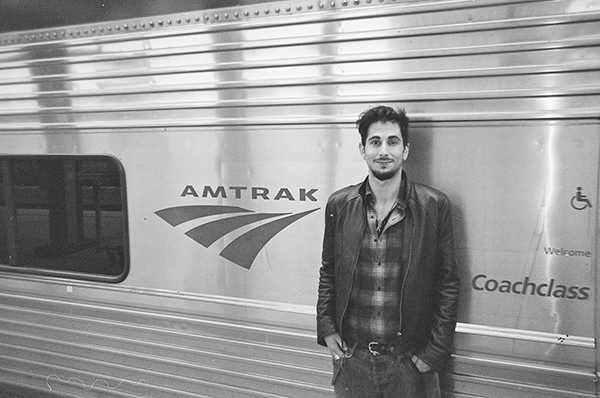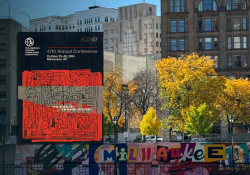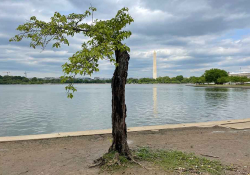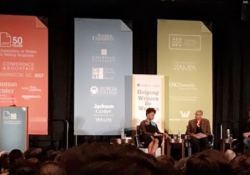Lost in the Vista Dome: Eastbound on the Zephyr

I land in Los Angeles and meet up with Mandy Kahn and David Shook, who’ve just returned from a week in Seattle, armed with a box of poetry from AWP. After Mandy drops us off, David and I grab a quick bite at Pho Café in Silver Lake, and at 1 a.m. I set off. There is no direct rail link from LA to Northern California, so I catch three Thruway Connecting Services to Sacramento. We cross the San Joaquin valley, which is dotted with olive groves and cherry trees in bloom. Between Bakersfield and Hanford, we pass by Delano, where the 1965 grape strike brought the plight of migrant workers to national attention. In the magazine I’m flicking through, there’s a picture of César Chávez with Bobby Kennedy, taken in early March 1968. Both men look exhausted: Chávez weakened by a month-long hunger strike, Kennedy probably by the intense pressure to declare his candidacy in the presidential elections. RFK has a five o’clock shadow, and his rumpled suit looks stiff with sweat. Three months later, he was dead. When I moved to Cape Town in mid-2013, RFK was also present, staring out of a book that contained the speeches he’d given in the wake of his brother’s death. One in particular, which he gave at the University of Cape Town on June 6, 1966, comes to mind as I’m about to cross the United States by train, in what is my first visit to the country:
I came here because of my deep interest and affection for a land settled by the Dutch in the mid-seventeenth century, then taken over by the British, and at last independent; a land in which the native inhabitants were at first subdued, but relations with whom remain a problem to this day; a land which defined itself on a hostile frontier; a land which has tamed rich natural resources through the energetic application of modern technology; a land which once imported slaves, and now must struggle to wipe out the last traces of that former bondage. I refer, of course, to the United States of America.
*
I reach Sacramento at 11 a.m. This is where I’ll board the California Zephyr, Amtrak’s longest western train, which rides through the High Sierra, past the deserts of Nevada and Utah through the Colorado Rockies, and into the farming plains of Nebraska and Iowa, where it crosses the Missouri and Mississippi rivers, the cornfields of Illinois, and finally reaches Chicago roughly fifty-one hours later. It’s easy to romanticize this journey; after all, it never made it into adulthood. The original California Zephyr, which entered service on March 20, 1949, was decommissioned on its twenty-first birthday. I’m about sixty years late for the heyday of the luxury limiteds in the 1950s, when the Zephyr was the “most talked about train in the country.” By the 1960s, the Boeing 707 and interstate highways had put an end its glory, but elements of the Zephyr survived in the misogynist stereotype of the sexy stewardess, or “Zephyrettes.” While the original, silver-bullet-shaped cars are long gone, the new Zephyr still features a slightly watered down—i.e., smaller—version of the “Vista Dome,” the glass-roofed viewing car that once afforded access to 180-degree views and was open to all. Once the Zephyr was decommissioned, some scouts working for Disney discovered one of the cars in an old rail yard in Moline and had it sent to Disneyland’s “California Adventure Park,” where it was turned into an ice-cream parlor and gift shop. In 2011 the Zephyr car was finally relocated to the Western Pacific Railroad Museum in Portola.
As the two-story Zephyr Superliner pulls up from Emeryville, its western kilometer zero, I pull out my copy of Jack Kerouac’s Big Sur (1961), which I haven’t read since I was a teenager, and which contains the first mention of the Zephyr I ever came across.
*
In 1960, after three years of drunken chaos—women who wanted to fuck him, men who wanted to fight him, all of whom also wanted to drink with him—Kerouac was washed out and wanted to be left alone. In June of that year, he wrote to Allen Ginsberg: “But what I really must do is get off by myself for first time since On the Road. . . . Have to have a holiday to rediscover my heart.” A few weeks later, Kerouac headed west to spend some time at Ferlinghetti’s cabin in Big Sur, ostensibly to try and dry out. He was unsuccessful, but during those three months, he acquired the material that would later fuel Big Sur, which he wrote in ten days on a sixty-foot roll of Teletype paper. It’s Kerouac’s finest novel: for the first time, he tells the truth about how he’d hurt himself and got bloated. Some might call it just another example of a Catholic venting his alcoholic paranoia, but at its best, its neurotic prose shatters the unspeakable loneliness of man into words. His Emersonian bouts of perfect clarity are instantly appealing:
. . . but who can’t sleep like a log in a solitary cabin in the woods, you wake up in the late morning so refreshed and realizing the universe namelessly: the universe is an Angel—But easy enough to say when you’ve had your escape from the gooky city turn into a success—And it’s finally only in the woods you get that nostalgia for “cities” at last, you dream of long gray journeys to cities where soft evenings’ll unfold like Paris but never seeing how sickening it will be because of the primordial innocence of health and stillness in the wilds. . . . So I tell myself “Be wise.”
Seven years after Big Sur, Kerouac was dead at forty-six. But before that, he went on one hell of a trip. From the opening passages:
Me drunk practically all the time to put on a jovial cap to keep up with all this but finally realizing I was surrounded and outnumbered and had to get away to solitude again or die—So Lorenzo Monsanto wrote and said: “Come to my cabin, no one’ll know,” etc., so I had sneaked into San Francisco as I say, coming 3,000 miles from my home in Long Island (Northport) in a pleasant roomette on the California Zephyr train watching American roll by outside my private picture window, really happy for the first time in three years, staying in the roomette all three days and three nights with my instant coffee and sandwiches—Up the Hudson Valley and over across New York State to Chicago and then the Plains, the mountains, the desert, the final mountains of California . . .
I can’t afford the kind of roomette Kerouac slept in. The Zephyr’s little cabins, which are 4 x 7 feet, come at around $1,000, so I’m in coach, which costs less than a third. Still, I ask Barbara, the conductor, if I can sneak a peek: the room’s bland, comfortable, and somehow soothing in its Spartan quaintness. Seeing that cabin underscores my rationale behind this trip, which is wholly unlike Kerouac’s. Whereas he needed solitude, I’m craving its opposite, and this, courtesy of a recent realization, is why I ride trains. Taking a page out of Henry Miller’s Big Sur and the Oranges of Hieronymus Bosch, the destination I am hopefully headed toward is not a place but rather “a new way of looking at things.”
Trains have the unique ability to pick up passengers according to roughly regular schedules and then take them slightly outside of time. Thus, the inner self is uncorked: you find yourself telling strangers about that girl you lost your mind over, that second husband you should never have married, that wild night you had with your best friend.
*
This will be my sixth or seventh long-haul train journey; I haven’t really kept track, nor do I plan to. But two trips in particular have left indelible impressions. In July 2007 I landed in Tallinn, took a thirty-six-hour train to Moscow, then the Trans-Siberian to Vladivostok. Over the course of those fifteen days, I couldn’t escape noticing it was often the poorest passengers who were usually the happiest to share their meals (the bread and hard-boiled eggs old head-scarved women sold us standing atop rickety footstools). Three years later, I spent two days hugging the eastern coast of India from Chennai to Kolkata and watched people perched on the roofs defy the laws of physics as they transformed into human ladders and hoisted unluckier travelers trying to catch up onto the moving train. However, it was only recently that I started asking myself why I’d become such a devotee of long-haul journeys. It struck me that trains that slice across time zones tend to liberate us from the watchful eye of the clock. Time, of course, is culture-specific, but wherever we happen to find ourselves, the outer clock of expectations and workplaces always imposes itself on our inner clocks, which instead determine how long we wish to talk to a loved one or consume a meal. Trains have the unique ability to pick up passengers according to roughly regular schedules and then take them slightly outside of time. Thus, the inner self is uncorked: you find yourself telling strangers about that girl you lost your mind over, that second husband you should never have married, that wild night you had with your best friend. Trains become stranger-free zones. All because you won’t see them again, so your secret is safe.
Whenever I parted ways with one of those new friends, I never said what I really wanted to say. We often say “thank you for your time” but never “thank you for taking my time.”
*
While the observations I made in Russia and India took years to crystallize, the irony’s just as fresh. Although trains are largely responsible for the frenetic pace of our modern lives, they also seem to be its perfect antidote: helping us rediscover the very humanity that we’ve lost touch with despite the ability to bridge distances once thought unfathomable. Regardless of where I was traveling—whether crossing Europe north to south or touring Morocco’s imperial cities on the colonial chemins de fer—I always noticed that most of my fellow travelers never had much money, and therefore had plenty of time on their hands. More often than not, they also had thoughts and feelings to fill those hours. Still, whenever I parted ways with one of those new friends, I never said what I really wanted to say. We often say “thank you for your time” but never “thank you for taking my time.” In those days, every time I found myself at an airport or station and about to set off on one of those journeys, I always thought I was running from something, whereas I was actually running toward something.
*
I’m traveling eastbound, but as with Kerouac, much of the appeal inspired by the Zephyr was, befitting its name, about traveling westward. Many in the 1950s and ’60s left their old lives behind for a fresh start in the Bay Area. It’s easy to see why. Anyone artistically minded in the early postwar years wanted a piece of anarchistic, free-wheeling “Frisco,” attracted by visions of a life evoked by Kenneth Rexroth in “The Mature Bohemians,” which he penned for The Nation in 1957, having resided in the city since 1928:
It is gradually getting around that a special kind of regional renaissance has been underway in San Francisco ever since the war. . . . Why? . . . It is easy to escape into any desired degree of wilderness. It is easy to get by. . . . Poetry out here, more than anywhere else, has a direct, patently measurable, social effect, immediately grasped by both poet and audience. This is far more important to us than publication in a book or magazine on the other side of the continent.
*
But the Babel of the Internet is very different now. As Rebecca Solnit poignantly put it, San Francisco has become a “bedroom community for the tech capital of the world,” where penniless beatniks have been replaced by engineers “who complain about not having time to spend their money.” Once a place where it was easy to get by, it’s now a “city that poets can’t afford.” At least it’s nothing out of the ordinary. When John Sutter woke up one morning in 1848, he discovered his sleepy Yerba Buena had become San Francisco, and the panhandlers who’d arrived in the wake of the Gold Rush had claimed all his land, for which he was never compensated. Fittingly, San Francisco has named a street after him.
*
I’m seated at the back of the carriage closest to the viewing car. The seats are blue, soft, and recline almost like first-class seats on an airplane. I cross into the viewing car, part of which is studded with swiveling chairs. While slightly smaller than the ones on the old Zephyr, the windows are still huge. We’ve hardly been on for an hour, but the viewing car is already full of gray-haired veterans with gold-braided Navy baseball caps. On the first leg of the journey, the carriages are filled with pensioners on holiday, most of whom get off at Truckee, our last California stop, or at Reno. Snippets of history are being read out along the route by the conductors, but the vets are mostly interested in their own stories while they sip from flasks of bourbon. There’s a café on the lower level of the viewing car, where I strike up a conversation with Martin, the barkeep, who’s from Milwaukee. He looks like an Irish boxer: short, lean, muscular, prominent cheeks, a face tightly pinched at the chin, close-cropped ginger hair and sharp eyes. Martin’s a history buff. He tells me the Zephyr is the only train that comes close to following the original transcontinental route, which Abraham Lincoln signed into life in 1862, and which employed over ten thousand Chinese laborers for seven back-breaking years. By the end of Grant’s presidency, the total mileage of tracks in the United States almost equaled that of the rest of the world put together.
*
We tootle across Nevada at seventy miles an hour. The tracks are cut in the white dirt. Golden sagebrush tufts out of the ground. We pass Virginia City, where miners struck the Comstock Lode in 1859: a silver deposit worth hundreds of millions. The kind of lucky strike that turns handfuls of shacks into fashionable cities. It reminds me of that scene in The Gold Rush, where Charlie Chaplin scurries about in a dingy shack on the edge of a cliff: a perfect metaphor for the mineral rat race that’s bleeding us dry. But where there’s money, there’s thievery. Halfway through the gambling state, we pass Winnemucca, where Butch Cassidy, as the loudspeakers in the viewing car inform us, once robbed the local bank. A few hours later, we finally reach the Great Basin, which spreads across Nevada and Utah: ridges and valleys once bathed by a freshwater sea, whose arid heir is now called the Great Salt Lake. The spellbinding dryness can’t help but recall the fact that great swathes of California, the Southwest, and the High Plains have been haunted by the ghost of drought since the late 1990s. While there are several reasons for this, the real glutton is industrial-scale agriculture. Perhaps because I was raised in the desert, I’ve always paid particular attention to water scarcity. Unlike hurricanes and tsunamis, droughts stick around. They’re one of nature’s most patient phenomenons.
*
In Salt Lake City, I meet Lenny, who is in his late sixties and hides his white ponytail under his hat. He’s joining the crew until Iowa. Lenny’s worked for Amtrak since its inception and before that for the Burlington Northern. He’s a lifelong union man, plays the steel guitar, and custom-designs his own choppers, one of which won a national prize. Lenny tells me that in their first decade, immediately after Nixon signed the National Railroad Passenger Corporation Bill in 1970, people thought Amtrak trains were best avoided. They had their reasons: the carriages were ramshackle, the food terrible, the crew never to be found. But throughout the 1980s and ’90s, Amtrak slowly eased its dependency on federal subsidies, and their Superliners today are very different beasts: spotless, comfortable, and fairly reliable. As for the crew, Lenny and Martin were perfect examples of the people you’re likely to meet on these trains: personable, witty, well-read, and well-traveled.
*
Twisting along the serpentine canyons of the central Rockies, we cross the six-mile tunnel under Rollins Pass, which stands at almost twelve thousand feet and was the longest railroad bore in North America until the early 1930s. Our first stop on the other side is Grand Junction, a major shipping center whose local economy is fueled by coal, shale, and uranium. Martin tells me this part of Colorado is full of old mines whose fires have never been put out, many of which are still quietly burning, barely noticed, and might do so for centuries still.
*
After a twelve-hour flight from London to LA, a sleepless night on Thruway buses, and a day and a half on the Zephyr, I can barely keep my eyes open. Once again, I’m lost in the vista dome, deep in conversation. Patrick and Maurice, two traveling salesmen working out in Seattle, keep me company. Maurice is from Memphis and oozes charm. He is twenty-three and unabashedly plainspoken. He has only a single goal in life: to make money. “Trouble is, in the meantime,” he added, sipping from his beer, “you forget to eat, you forget to live.” At Denver, the first stop in a few hours where we’ve got enough time for a cigarette, we get off and light up. Our breaths hiss white as we stretch our legs. Patrick, who is part Mexican, Italian, Cherokee, and Irish, is all teeth and moustache, and looks like a young Danny Trejo. He’s well aware of the likeness, and has written a movie script where he wants to play the young Trejo. Before long, the talk shifts to spirituality. Patrick is a Nation of Islam five-percenter, and he explains some of their core tenets. It hasn’t escaped me how often the subject of God has come up on trains. Perhaps being in motion is a substitute for the itinerarium mentis in Deum: the journey of the mind to God. Patrick and Maurice discuss their plans. Their ambition is insatiable, and infectious.
*
I never saw Nebraska. The sun set sometime before Ft. Morgan, west of Denver. Although the Zephyr is specifically timed so passengers see the highlights during the day, Nebraska didn’t quite make the cut. “That’s just as well,” Lenny tells me, “there’s nothing to see!” To mitigate the impenetrable darkness through the window, I read Robert Louis Stevenson’s thoughts on Nebraska, excerpted from Across the Plains (1892):
To one hurrying through by steam there was a certain exhilaration in this spacious vacancy, this greatness of the air, this discovery of the whole arch of heaven, this straight, unbroken, prison-line of the horizon. Yet one could not but reflect upon the weariness of those who passed by there in old days, at the foot’s pace of oxen, painfully urging their teams, and with no landmark but that unattainable evening sun for which they steered, and which daily fled them by an equal stride. . . . But what is to be said of the Nebraskan settler? His is a wall-paper with a vengeance—one quarter of the universe laid bare in all its gauntness. His eye must embrace at every glance the whole seeming concave of the visible world; it quails before so vast an outlook, it is tortured by distance; yet there is no rest or shelter till the man runs into his cabin, and can repose his sight upon things near at hand. Hence, I am told, a sickness of the vision peculiar to these empty plains.
*
Dawn breaks in Creston, Iowa: the sky is a soft pink and the fields covered in sugary snow, hay tufting out of them like mohawks. I try to picture these plains as they once were: a vast sea of buffalo and tallgrass. I turn to William Least Heat-Moon’s Roads to Quoz (2008):
Then the future came wearing shoes cut out of cows and pants woven on a machine. It found bison a nuisance. The beasts took valuable grass from cattle, stampeded crops, interrupted trains, knocked over telegraph lines. And so the American bison, a symbol to both red and white, disappeared even faster than the way of life it engendered.
It appears the Great Plains are on the verge of another transition, which might see the settlers’ descendants go the way of the buffalo. Reports tell us the family farm is dying, with small landowners routinely selling their plots—and/or irrigation rights—to industrial holdings.
*
In Riding the Rails: The Great American Train Story, a documentary he presented in the early 1970s, Johnny Cash says: “When I was a boy, the trains ran past my house, and they carried with it the promise that somewhere down the track, anything would be possible, and you know for some reason it was awfully important to me that when I waved at the engineer that he waved back at me.” Watching this before leaving London, it reminded me of a short story I’d long wanted to read, Thomas Wolfe’s “The Far and the Near” (1935). Under 1,500 words, a rare feat for the profligate author, the story’s protagonist is a train engineer who’s “grown old and gray in service.” For twenty years, he’s blown on his whistle and drawn comfort from the sight of a little house on his route where every day, at two o’clock in the afternoon, a woman and her little girl would gather on the porch and wave to him, breaking “the iron schedule of his days.” When the engineer finally qualifies for his pension, he immediately sets out to find the two women, but everything on his path suddenly bewilders him; the town he passed through ten thousand times seems unfamiliar, as do its denizens and, of course, the two women he goes to meet. For a few awkward moments, the engineer sits in their “ugly little parlor,” and his halcyonic vision, which had comforted him all those years, is replaced by a face that’s “harsh and pinched and meager” whose “small eyes peered at him with timid suspicion and uneasy doubt.” Here’s how the story ends:
He walked away down the path and then along the road toward town, and suddenly he knew that he was an old man. His heart, which had been brave and confident when it looked along the familiar vista of the rails, was now sick with doubt and horror as it saw the strange and unsuspected visage of an earth which had always been within a stone’s throw of him, and which he had never seen or known. And he knew that all the magic of that bright lost way, the vista of that shining line, the imagined corner of that small good universe of hope’s desire, was gone forever, could never be got back again.
*
By the end of the journey, very few people I’d seen board the train in Sacramento got off in Chicago, maybe half a dozen, perhaps fewer. As many as a couple of hundred came and went, disembarking along the way, but Maurice and Patrick are among the crowds at Chicago’s Union Central, so we linger and chat before Patrick heads to Houston and Maurice to Memphis. As I watched them leave, realizing the first leg of the journey had finally come to an end, I couldn’t help asking myself whether I’d learned anything at all about Americans, whose identity, as John Steinbeck remarked in Travels with Charley: In Search of America (1962), is an “exact and provable thing”:
Americans are much more American than they are Northerners, Southerners, Westerners, or Easterners. And descendants of the English, Irish, Italian, Jewish, German, Polish are essentially American. This is not patriotic whoop-de-do; it is carefully observed fact. California Chinese, Boston Irish, Wisconsin Germans, yes, and Alabama Negroes, have more in common than they have apart. And this is the more remarkable because it has happened so quickly. It is a fact that Americans from all sections and of all racial extractions are more alike than the Welsh are like the English, the Lancashireman like the Cockney, or for that matter the Lowland Scot like the Highlander. It is astonishing that this has happened in less than two hundred years and most of it in the last fifty.
While proving the notion would take far longer than the time at my disposal, I did partake in what Steinbeck referred to as a “popular sport in Europe,” in other words, “to describe what the Americans are like.” The people I’d met on the trip didn’t seem much interested in fast cars or big wages—or rather the superficial clichés of the American dream—instead, they appeared wholly focused on their peculiar, individual quests to free themselves from their Republic and install themselves in their own private utopias, whether this happens to be in the suburbs or the mountains of Colorado. I hazard the Republic will remain largely as is, so long as this concept remains viable for sufficiently large a minority. It is ironic that this anarchic vein in American society is the very lifeline that keeps its Republic alive; that the very genius of the nation founded by Adams, Hamilton, and Jefferson was that it created a government that provides enough form to allow its citizens their own measure of formlessness.
*
It is ironic that this anarchic vein in American society is the very lifeline that keeps its Republic alive; that the very genius of the nation founded by Adams, Hamilton, and Jefferson was that it created a government that provides enough form to allow its citizens their own measure of formlessness.
Continuing my journey across the country on the Lake Shore Limited to New York, I read an article where David Gunn, Amtrak’s president from 2002 to 2005, was quoted telling a Senate hearing that the company “will never be profitable.” After crossing eleven states on my way to rural New Hampshire, I inevitably found myself dazed by the sheer magnitude of the country, a good chunk of which is only kept connected by Amtrak, which still services flag stops, towns too tiny for most other entities to care much about. Such a service should be conceded the rare honor of being exempted from endless enquiries into its profitability. In 1972 Gore Vidal made an impassioned plea: “We should have a national health service, something every civilized country in the world has. Also, improved public transport (trains!). Also, schools which do more than teach conformity. Also, a cleaning of the air, of the water, of the earth before we all die of the poisons set loose by a society based on greed.” Still, passenger numbers on the Zephyr are up, and its customers are happy. Before I left the Lake Shore Limited at Penn Station, I caught a glimpse of a poster advertising National Train Day. The bottom line reads: “BECAUSE TRAINS MATTER.” I couldn’t agree more.










